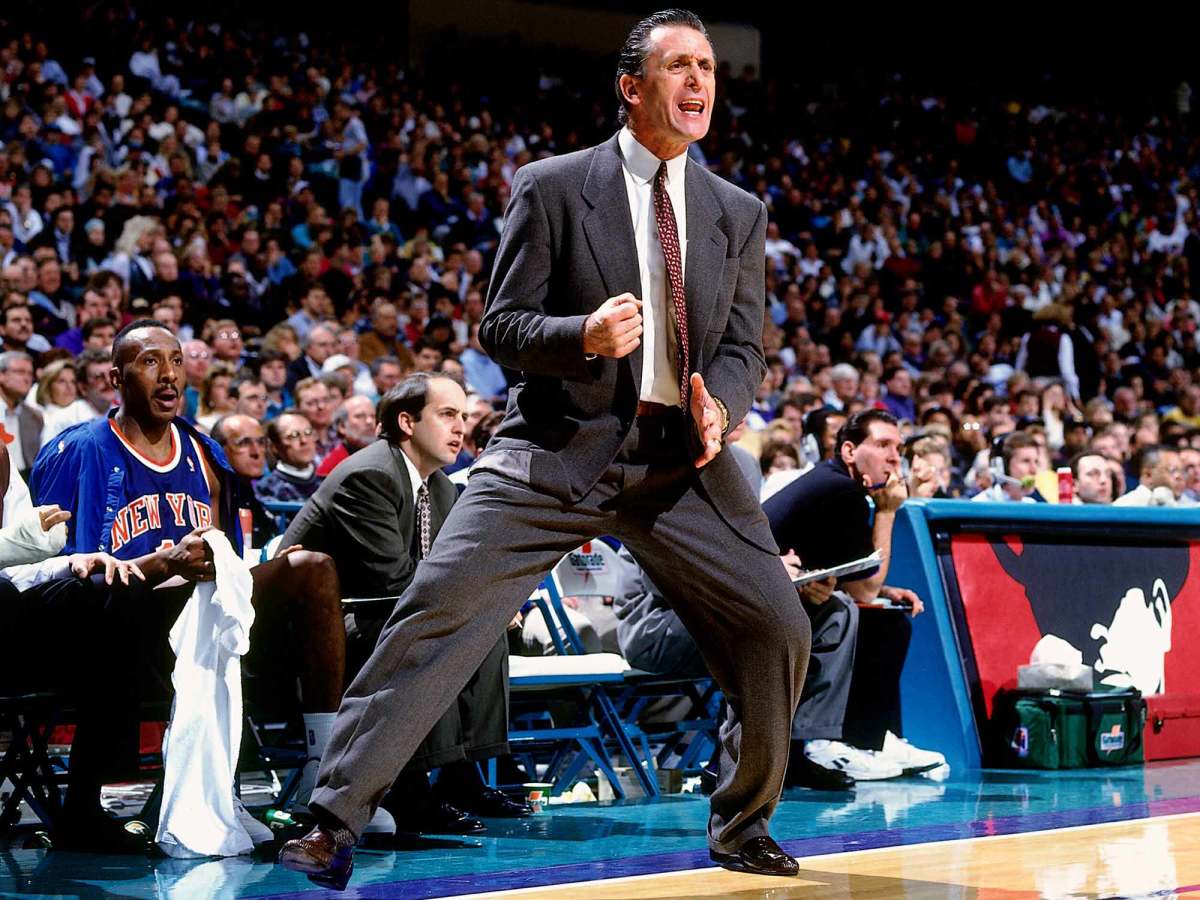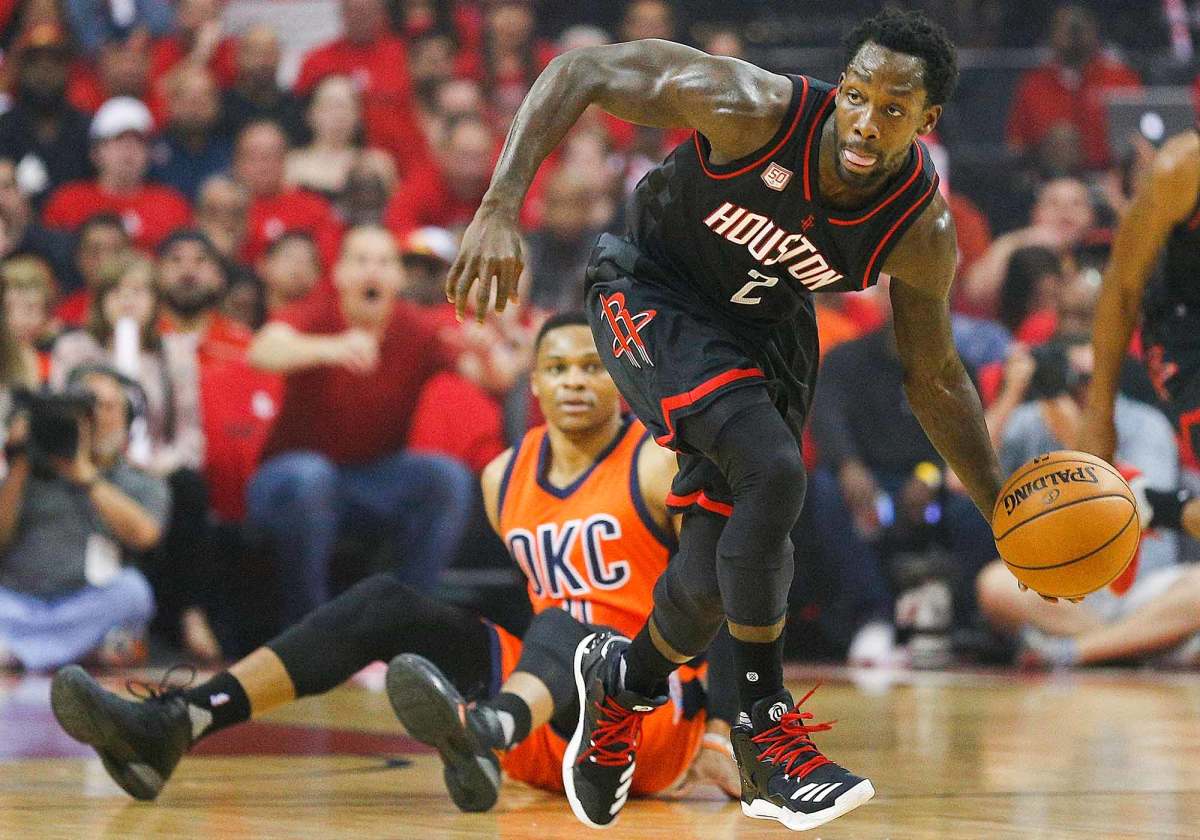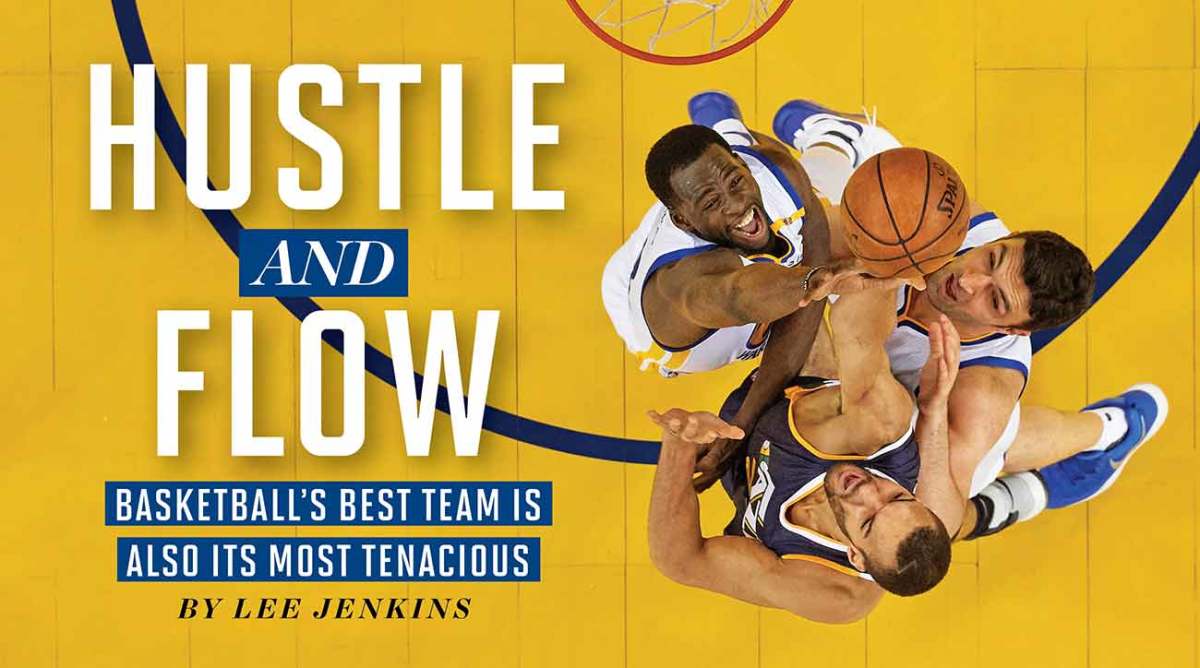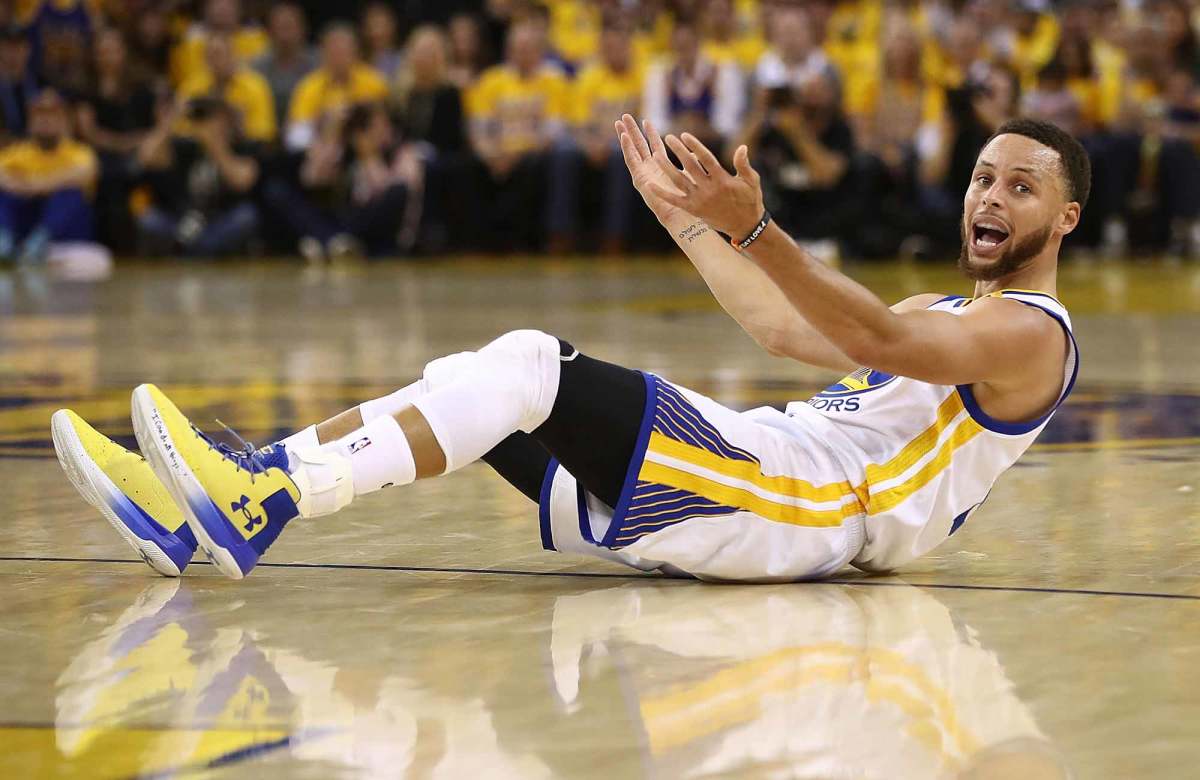The Warriors' Deadly Combo Of Hustle And Flow

This story appears in the May 15, 2017 issue of SPORTS ILLUSTRATED. To subscribe to the magazine, click here.
In the winter of 1994, as the vaunted Knicks trudged through a tedious West Coast road trip, Pat Riley cut a deal with his potent but listless team. The slicked-back coach offered to pay players $100 for every charge they took, adding a Benjamin to the price with each successive victory. The incentive program was against NBA rules, of course, but Riley was far more concerned with securing the No. 1 seed in the Eastern Conference than any potential punishment. The Knicks promptly snapped a four-game slide at Sacramento, beat the Nets at Madison Square Garden, then swept a three-game trip, a five-game home stand and another three-game swing. "By the time we won 15 in a row," recalls Jeff Van Gundy, an assistant coach under Riley, "he was paying out like $1,500 a charge."
For Patrick Ewing, Anthony Mason and John Starks, the extra income didn't matter much. But the last guy on the Knicks' bench was a 6'9" power forward from Indiana named Eric Anderson, who earned $150,000 a year, the league minimum. "Toward the end of the streak, we're in the last couple minutes of a blowout at the Garden, and Anderson goes in," Van Gundy remembers. "He's running around all over the place, throwing himself in front of every drive, flopping like a charge whore. He gets the first call, bounces up and screams at the bench. There's $1,500! Then he takes another one. There's $3,000! In two minutes I think he made about three grand, and the next day at practice, coach Riley paid it off."
Even when he had no cash at stake, Riley ordered Knicks assistants to keep track of charges and deflections, loose balls and contested shots—his rudimentary attempt to quantify one element that is ultimately immeasurable: effort. Riley posted results in the locker room, lauding those players who excelled in the categories beyond the box score, shaming those who lagged. "You saw at halftime where you ranked," says former marksman Kiki Vandeweghe, who spent one season spacing the court for Riley in New York. "If you wanted to play in the second half, you ranked high."

Vandeweghe joined the Mavericks' coaching staff in 1999, and when he wasn't passing out water and towels, he was charting for Don Nelson the same kind of data Van Gundy and Dick Harter collected for Riley. "Hustle stats," Vandeweghe calls the figures, which make the intangibles tangible. When Vandeweghe was hired as the Nuggets' general manager in 2001, he came to the conclusion reached by evaluators everywhere: Effort is a skill, the same as vision and footwork. Vandeweghe searched for players who would scrap, scouring film and interrogating scouts. But he could never find quantifiable evidence. By the time Vandeweghe landed at the NBA office as vice president of basketball operations in '13, hoop-heads were versed in Player Efficiency Rating (PER) and Wins Above Replacement Player (WARP), among dozens of elaborate metrics that extol LeBron James. Yet there was still no universal method to identify the glorious grinders who lay sledgehammer screens on one end and gum up passing lanes on the other.
Watch & Learn: Studying The NBA’s Silent Stars
Hustle stats were scarce in part because they are subjective. While a computer can spit out a heat map, it can't gauge the quality of a shot challenge. For that, you need humans, trained to consume games as Riles intended. Which is why, starting this season, the NBA hired 15 new employees to track every deflection, contest, charge, loose ball and screen assist. The numbers are distributed to teams and available to fans on NBA.com. The loggers are former high school coaches, college players, camp counselors and referees. They are round-ball junkies like Andre Blackwood, 25, who played at Paramus Catholic when Cavaliers guard Kyrie Irving was at nearby St. Patrick's. "St. Pat's beat us by 70 points in a scrimmage once," Blackwood recalls, "and Kyrie was still diving on the floor at the end." Now Blackwood sits in front of a monitor every night at the league's headquarters in Secaucus, N.J., eyes fixed on those loose balls.
All eight second-round teams, the loggers discovered, employ at least one Charlie Hustle. Patrick Beverley, Houston's Doberman pinscher of a point guard, snagged the most loose balls per game this season (1.6). Washington's Marcin Gortat and Utah's Rudy Gobert set the most screens that led directly to buckets (6.2), with Cleveland's Tristan Thompson not far behind (4.8). Toronto's Kyle Lowry rated fifth in deflections (3.7), just ahead of San Antonio's Kawhi Leonard (3.4). Boston's Marcus Smart was fifth in total charges (24), edging Beverley (22). Gobert also shone in multiple columns, finishing second in two-point contested shots (12.7), as did Wizards point guard John Wall, tied for third in deflections and second in loose balls.

Washington and Toronto delivered admirable efforts across the board, in contrast to Cleveland (27th in deflections, 24th in loose balls and contested shots) and Utah (30th in deflections and charges, 29th in loose balls and contested threes). Then again, the woeful Nets were No. 1 in contested shots, so the Cavs may not want to trade LeBron for Tony Allen yet. The Spurs were an equally uninspired 26th in loose balls and 28th in contested threes, albeit sixth in contested twos. The Rockets, prioritizing the perimeter, were almost opposite: eighth in contested threes and 22nd in twos. Coaches emphasize different aspects, and if Jazz defenders don't tip passes, that's partly because they resist the urge to gamble.
The program, conceived by Vandeweghe and managed by NBA director of analytics Jason Rosenfeld, is evolving. But it has already underlined the widely held assumption that players can coast during winter and surge come spring. Through the first round, deflections, charges, contests and screen assists were all up from the regular season, and loose-ball recoveries had nearly doubled. Even the Rockets, who won 55 games and rejected opportunities to rest, were prying 15.6 loose balls per game, compared to 7.2 in the regular season.
So who, after six months of scrambling and scribbling, owns the hustle? Turns out the most talented team is also the most tenacious.
"Oh, this is my area," crows Draymond Green, Golden State's outspoken and indefatigable power forward, "because this is about energy. You can get an assist without expending energy. You can score a point without expending energy. Sometimes you can even get a rebound without expending energy. But you don't set screens without expending energy. You don't contest shots without expending energy. You don't get deflections—unless you walk into one every now and then—without expending energy. These are the things in basketball you have to really want to do."
Warriors practices are closed to the public, but players acknowledge that their scrimmages can feel flat. The regulars pace themselves and the reserves, well aware of the roster hierarchy, know they aren't taking minutes from Kevin Durant. But something changes when they're under the big top. The four-star juggernaut that won 67 games this season, that led the NBA in field goal percentage and field goal percentage defense, that posted a higher net rating and point differential even than last year, outworked everybody too. The Dubs created the most deflections (18.7) and corralled the most loose balls (7.7), while racking up the second-most contested shots (68.4) and screen assists (12.7). After their opening-round sweep of the Blazers, they led three of the five major hustle categories in the playoffs.

"We'd be good even without all that," Green continues. "We'd be damn good. You look around the league, you see a lot of stars who don't make these kinds of plays, and they still have good teams. But they're not serious. They're not chasing greatness. We are, and we realize these plays are the difference between the stars that win and the stars that lose. So when you combine the little things we do with the skill and the talent and the dynamic scoring, then all of a sudden you have a f------ animal that's almost impossible to contain."
It is no surprise that Green, a 6'7" stopper, rated first among forwards, according to the NBA's aggregate hustle stat. But Steph Curry, whose defensive vigor prompted eye rolls from Durant and Russell Westbrook a year ago, finished second among guards. In the postseason Curry is No. 2 in loose balls, while Green is No. 2 in contests. "But I have to do that," Green interjects. "Steph doesn't. All you ever hear is, 'Oh, man, Steph Curry, best shooter in the world! Klay Thompson, 60 points in three quarters! KD, freak of nature, in-and-out crossover full-speed transition tomahawk! And, hey, that s--- is sexy, so you fall in love with it. But there's sexy s--- all over the NBA. Don't forget about the other reasons we win."
When the Warriors hit a rare rough patch in late February and early March, dropping five of seven games, they slipped in four hustle categories. Green did not need the numbers to detect the drop. If he misses a couple three-pointers, and stops shooting as a result, Curry and Durant yell at him to keep firing. But if they blow a screen or a rotation, he's the one who erupts. "Like I said," Green explains, "my area." Golden State got back on the grind by St. Patrick's Day and has lost once since, reeling off eight straight wins to start the playoffs.
Daring To Dream Outside Of Warriors-Cavs III
In one first-round possession—early in the third quarter of Game 3, with Portland leading by 13 points—Green guarded five Blazers in a span of 11 seconds, scurrying from Evan Turner on the left wing to Moe Harkless in the paint to Jusuf Nurki´c on the right block, then shutting down a C.J. McCollum drive at the free throw line and finally altering a Damian Lillard three atop the circle. "It takes energy," Green says, "but also understanding. Think about the deflections. The offense can't score every play. They're just trying to get a good shot. If I can deflect a pass, even if it doesn't cause a turnover, it will throw their timing off half-a-second. That half-a-second might mess up their shot. But to do it, I have to read the situation and know where they want to go, what they want to do."
Activity is not enough. The NBA tracks how many miles per hour everybody moves on the court, and out of 486 players, James Harden is No. 481; Wall, 476; James, 475; Blake Griffin, 474; Green, 459. "What really matters is the effectiveness of the movement, not the energy," adds Daryl Morey, the Rockets' general manager. "All else equal, more hustle is better than less hustle, but the reality is less hustle from Michael Jordan is better than more hustle from Gerald Wilkins." Aptitude and awareness, strength and quickness, hand size and wingspan, are all ingredients in a complex formula. Effort is only the most obvious one.
In the summer of 2015, Houston point guard Patrick Beverley was a restricted free agent and Morey had a decision to make. Beverley was coming off a season in which he averaged 10.1 points, 3.4 assists and missed nearly three months recovering from surgery to repair a torn ligament in his left wrist. But Beverley's value extends beyond even the most advanced metrics. "We've always kept our own internal hustle stats, and we looked at those heavily," Morey recalls. "Pat graded out very well on that stuff: loose balls, switching onto bigger players, some things you can measure and some you can't."
The Next Step For John Wall And The Wizards
Morey handed Beverley a four-year, $25 million contract, and bet the money wouldn't change him. "One of the hardest things to predict is whether players will have the discipline to keep improving, keep working," Morey says. The deal turned out to be a bargain, with Beverley first among guards in the NBA's aggregate stat, setting up a possible Hustler's Ball with Green in the Western Conference finals. "Guys like Pat, who really had to fight their way into the league, I find often continue to work more than guys who made it on physical tools alone," Morey reasons. "Guys who are born with more athletic gifts are able to make it with less work."
Indeed, Beverley was drafted 42nd, Green 35th, Gobert 27th, Gortat 57th. "But this is where you run into murky territory," warns Golden State assistant Ron Adams, architect of the Dubs' defense. "Effort is very apparent when you're talking about the limited player who by sheer will and drive makes it into the mainstream. It's apparent why Beverley is Beverley and Draymond is Draymond. It's less apparent why Kevin Durant is Kevin Durant. But you can't say the effort isn't the same with someone of a higher skill level to maintain what they do." Effort, after all, is expended in different ways by different people—whether it's Durant fighting through three defenders to reach his sweet spot at the elbow or Green climbing over a double screen to contest a corner three.

"You know, I don't even call it a contest," Adams clarifies. "I call it a challenge. But here's another thing to consider: Your idea of a challenged shot may not be the same as my idea. If somebody closes out with his hand up, staying on the ground, is that a challenged shot? To me it's a half-assed challenged shot." Adams teaches the Warriors to elevate when they close out, rising as if to snare an alley-oop. NBA loggers use a softer standard, awarding a contest to a defender who has "done everything he can to affect the shot," which includes "closing out and getting a hand up." Not all contests—or deflections—are created equal. A deflection is granted when a defender "interrupts the pass of the ball." If Curry intercepts a pass from James, for example, he is given a steal and a deflection. If James dribbles a ball off his foot and Curry grabs it, he is only given a steal. "I think it's important to remember we're not playing baseball," Adams cautions. "There are some things you just can't quantify."
The Warriors' switches. The Celtics' rotations. "The secret sauce," Vandeweghe says, "the basketball feel." Charges and deflections, he believes, are just the tip of an informational iceberg. He thinks about other figures Riley would have requested. He wants them for the teams, the fans and the grinders like Green, who contribute in all the ways that are difficult to calculate.
"Really, it's not even for me anymore," Green says. "It's more that I want to create another lane to the NBA, and these numbers help. We can't all shoot like Steph. We can't all be 7-feet and move like KD. But that doesn't mean you can't do something just as important. So many times I watch games and think, Man, why is that guy trying to score like that, he can't do it.' But he's been told his whole life, 'You have to go get 40 if you want to be one of the top dogs.' It's my goal to build a lane where you can be a top dog and you don't gotta go get that 40. You can go get four and still be a top dog."
